In my last post I showed a game between Ian Nepomniachtchi and Sam Shankland where “Nepo” played a favorite opening line of mine and won brilliantly. Curiously, this is not the first time he has done that!
Here is a game that Nepo won against Anish Giri in 2013, featuring a double piece sacrifice. It’s a blitz game (5 minutes) played in Beijing. One always wonders how seriously to take a blitz game: were the sacrifices sound or were they bluffs? The answer in this case (confirmed by Rybka) is that they were completely sound. In fact, this might well have been home preparation by Nepomniachtchi, but I don’t think that detracts from the brilliance of his play.
Nepomniachtchi, Ian — Giri, Anish
Grunfeld Defense
1. d4 Nf6 2. c4 g6 3. Nc3 d5 4. Nf3 Bg7 5. h4!?
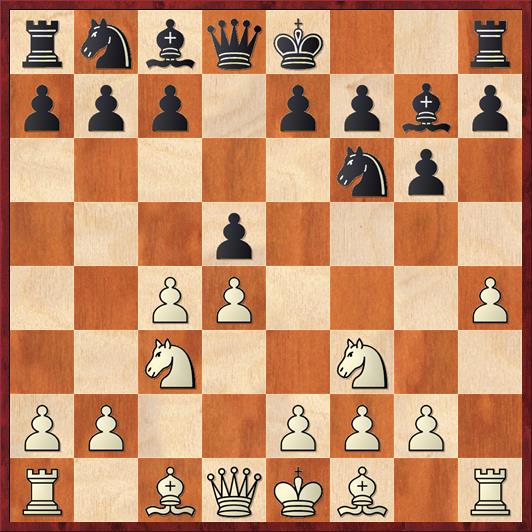 Position after 5. h4. Black to play.
Position after 5. h4. Black to play.
FEN: rnbqk2r/ppp1ppbp/5np1/3p4/2PP3P/2N2N2/PP2PPP1/R1BQKB1R b KQkq – 0 5
This early thrust has been played 300 times in ChessBase, almost all of them since 2012. In fact, the first time it appeared in games between super-GM’s was in two games between Morozevich and Giri that year, both of which Morozevich won. I’m sure that Nepomniachtchi must have noticed, so when it was his turn to play against Giri he decided to play Morozevich’s offbeat move.
I was actually experimenting with a super-early h4 even earlier than this. In 2010 I played it against IM Dmitry Zilberstein: 1. d4 Nf6 2. c4 g6 3. Nc3 d5 4. h4!? c6 5. Bg5 Bg7 6. e3. Here I could have played 6. Nf3 transposing into the game you’re about to see, but at the time I did not know whether the pawn sac was sound, so I decided to play it safe. In fact, I think I got a very good position after 6. … Be6 7. Bxf6 Bxf6 8. cd cd 9. Qb3 Qb6 and here, instead of 10. Bb5+?!, I should have played 10. Qxb6 ab 11. Ne2! with a nice positional advantage. The idea is to play Nf4, Nxe6, and f4, permanently shutting in Black’s dark-squared bishop.
However, the trouble with the super-early h4 is that, instead of Zilberstein’s 4. … c6, Black can play 4. … c5! In the game continuation, 4. Nf3 Bg7 5. h4, now 5. … c5? is not so good after 6. dc. The point is that White now controls the d4 square with the f3 knight as well as the queen, so Black can’t play … d5-d4.
Okay, now back to Beijing and the game between Nepo and Giri.
5. … c6 6. Bg5 dc
This is the move I was afraid that Zilberstein would play. Does White get enough compensation for the pawn?
7. e4 b5 8. e5 Nd5
A Slav-like position with the atypical moves … g6, … Bg7, and h4 inserted. For the move h4 to have any meaning, White has to keep on pushing the pawn.
9. h5 …
A good “anti-draw” variation. This position has occurred 10 times according to ChessBase, and none of them were draws! Six White wins, four Black wins.
9. … h6
 Position after 9. … h6. White to move.
Position after 9. … h6. White to move.
FEN: rnbqk2r/p3ppb1/2p3pp/1p1nP1BP/2pP4/2N2N2/PP3PP1/R2QKB1R w KQkq – 0 10
Giri throws down the gauntlet…
10. hg! …
And Nepomniachtchi accepts it! The sacrifice leads to a position where Black is two pieces up but his king is bereft of defenders.
10. … hg?
This has to be considered a mistake, but I think that we should at least give Giri credit for bravery. He’s going to force Nepo to prove that his sacrifice is sound. Since this game, Black players have simply taken back on g6, when White has some compensation for his pawn thanks to the weakened Black kingside.
11. Rxh8+ Bxh8 12. gf+ Kxf7
Black couldn’t allow the f-pawn to remain on the board — it is too dangerous.
13. Nxg5+ Kg6
There is no shelter on the queenside after 13. … Ke8 14. Nxd5 cd 15. e6.
14. Qf3! …
So cold-blooded! Nepo says, “Go ahead and take my other knight! I don’t need it.” On the alternatives, like 14. N3e4 Qa5+ or 14. f4 Ne3, White’s attack loses a lot of its steam.
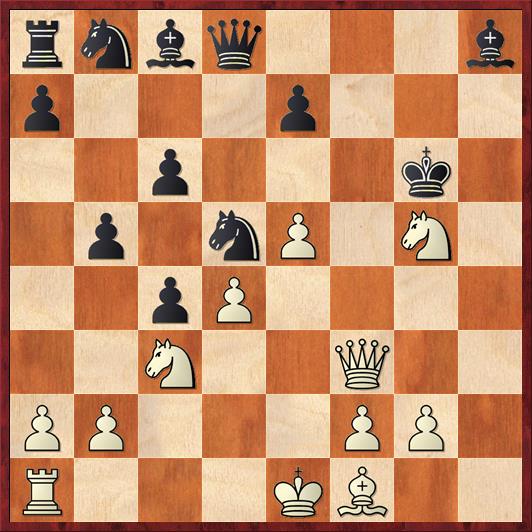 Position after 14. Qf3. Black to move.
Position after 14. Qf3. Black to move.
FEN: rnbq3b/p3p3/2p3k1/1p1nP1N1/2pP4/2N2Q2/PP3PP1/R3KB2 b Q – 0 14
Black really has to accept the second sacrifice. The knight on g5 is, after all, a powerful attacker. The question is whether to accept immediately or to insert 14. … Nxc3 first. Because it was a 5-minute game, I think that Giri had to decide mostly on intuition. If he allows the knight on c3 to remain on the board, it too could turn into a powerful attacker. The sensible thing for him to do is remove as many attackers as possible, so he takes on c3 and then on g5.
Surprisingly, though, the computer (given enough time!) thinks that taking immediately is the better option. As it turns out, the reason for keeping the d5 knight on the board now is so that Black can give it away later! After 14. … Kxg5! 15. Qf7 could be met by 15. … Nf6 and 15. Be2 could be met by 15. … Kg6 16. O-O-O Nf6. Don’t forget, after giving back this knight Black is still a piece up, and his bishop and queen get to move to squares where they can defend the king more effectively.
After 14. … Kxg5, therefore, Rybka says that White’s best move is the direct 15. Qg3+ with a slight advantage. For instance, if 15. … Bg4 16. Be2 wins back a piece and maintains a strong attack. Or if 15. … Kh6 (best, according to Rybka) 16. O-O-O threatens mate on the h-file. Black can defend with 16. … Qe8 but now 17. Nxd5 cd 18. Bxc4! Qh5 19. Bxd5 wins back all the sacrificed material.
But Giri, as I said, preferred the more “natural” defense:
14. … Nxc3 15. bc Kxg5
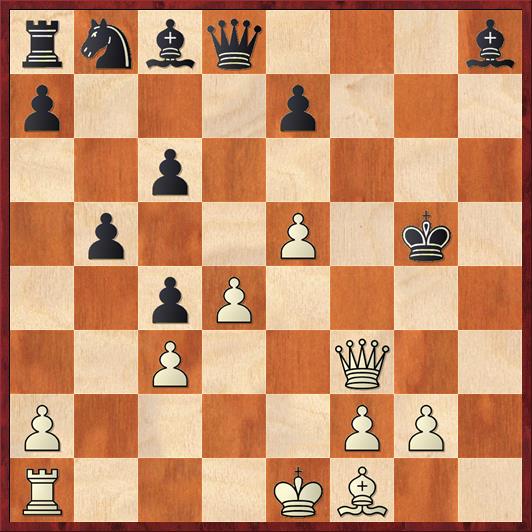 Position after 15. …Kxg5. White to move.
Position after 15. …Kxg5. White to move.
FEN: rnbq3b/p3p3/2p5/1p2P1k1/2pP4/2P2Q2/P4PP1/R3KB2 w Q – 0 16
The last position was a really critical one for Black; this one is critical for White. What would you do, and why?
Best, according to Rybka, is 16. Be2. One point of this moves is not subtle at all: White threatens mate with 17. Qh5+. However, there is also a deeper point that is not within human ability to see in a 5-minute game, even for grandmasters. Rybka says that best play is 16. … Qe8 (defending the mate threat) 17. O-O-O Kh6 18. Rh1+ Kg7 19. Qg3+ Qg6 20. Qh4 Kf8! 21. Qxh8+ Qxg8 (diagram).
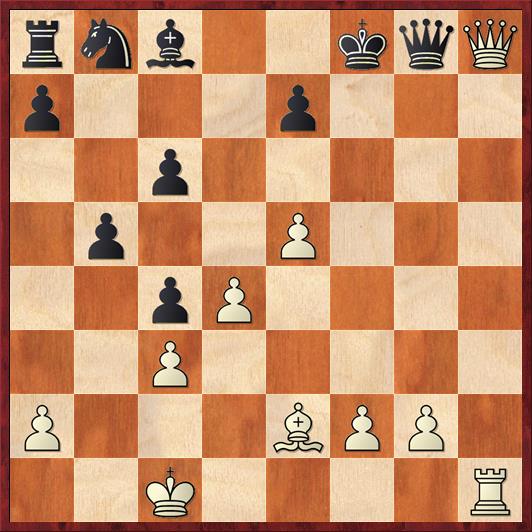 Position after 21. … Qxg8 (analysis). White to move.
Position after 21. … Qxg8 (analysis). White to move.
FEN: rnb2kqQ/p3p3/2p5/1p2P2R/2pP4/2P5/P3BPP1/2K5 b – – 0 22
It seems as if Black may be surviving, because it’s not obvious how to improve White’s position. I don’t think that one player in a hundred could find what the computer says is White’s only winning move here. Can you?
(extra space in case you want to try)
(nah, forget about it)
The answer is the ultimate quiet move: 22. Rh5!! When I saw this move on the computer, at first I couldn’t even understand what White is trying to do. Well, of course this move prevents 22. … Bf5. But you can’t checkmate your opponent with preventive moves. Somewhere there has to be a threat.
Well, the threat here is 23. e6! If Black doesn’t take the pawn, White will follow up with Rf5+, prying the king away from the defense of the queen. If Black takes the pawn with 23. … Bxe6, then 24. Qh6+ either picks up the bishop after 24. … Qg7 25. Qxe6, or else it puts Black in a world of hurt after 24. … Ke8 25. Rg5.
So that’s the first point. The second point is, of course, that Black can’t trade queens because 22. … Qxh8 23. Rxh8+ Kg7 24. Rxc8 wins the bishop. A third point is that 22. … e6? (to stop White’s advance) 23. Qf6+ is curtains. And the fourth, downright diabolical point, is that Black is basically in zugzwang. He would like to play a move that defends the bishop, but every move has something wrong with it. 22. … Be6 loses the bishop by the same combination as before. 22. … Nd7 allows 23. Rf5+ straightaway. 22. … Na6 leaves the c-pawn unguarded, and the computer says that White has a winning advantage after 23. Qh6+ Qg7 24. Qxc6 (although this is less than 100 percent obvious to human eyes).
In spite of all of this, I would argue that the so-called “best move” 16. Be2 is not necessarily the best move for human chess. It’s a good move, a reasonable move, but it has a problem: it lets the Black king escape to f8. It’s only by a miracle that we are still able to win after that happens.
Therefore, Nepomniachtchi does not play the computer “best move,” he plays the human “best move.” (Go back up to diagram 4.)
16. Qf7! …
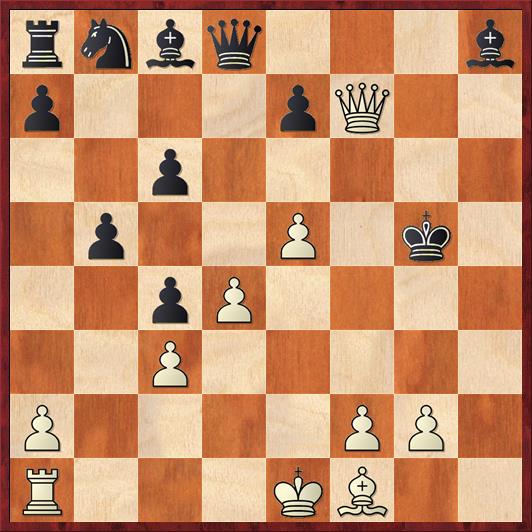 Position after 16. Qf7. Black to move.
Position after 16. Qf7. Black to move.
FEN: rnbq3b/p3pQ2/2p5/1p2P1k1/2pP4/2P5/P4PP1/R3KB2 b Q – 0 16
The point behind this move is that Nepo does not want Black’s king to be able to escape to his own lines. The grandmaster’s intuition, based on thousands of games of play and study, is that the best way to checkmate a lone king is to weave a mating net around him, not to chase him all around the board.
Of course there are exceptions to this rule. This game is an exception: Nepo’s move allows Black a miracle draw, while the other move (16. Be2) gives White a miracle win, if he is ingenious enough. But most of the time, it would be the other way around. Therefore, if you are a chess student, you would be well-advised to understand Nepo’s move first, and only after that to understand the computer’s move. This is why it’s harder to learn from computers than from human masters, even though computers give us the illusion of greater understanding.
Now Giri played
16. … Qd5!
An excellent move, and probably one of the reasons he chose to play 14. … Nxc3.
17. Qxe7+ Kh6 18. Qf8+ Bg7 19. Qxc8 …
All pretty much forced, and now Black can just about force a draw. Do you see how?
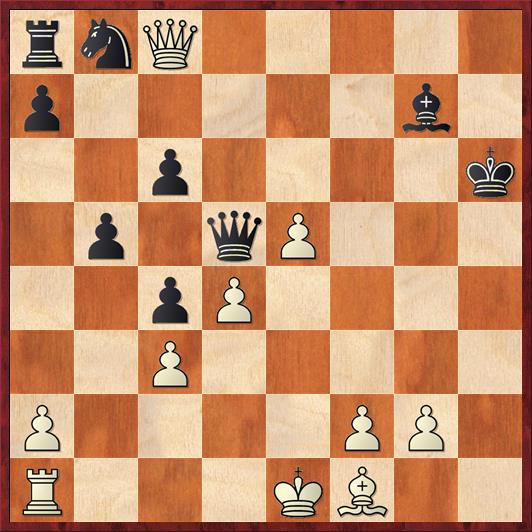 Position after 19. Qxc8. Black to move.
Position after 19. Qxc8. Black to move.
FEN: rnQ5/p5b1/2p4k/1p1qP3/2pP4/2P5/P4PP1/R3KB2 b Q – 0 19
Here the drawing line is 19. … Qd7! 20. Qg8 Qd5! Amazingly, White’s queen has no way to get away from the “perpetual check” by Black’s queen. The only possible try is 21. e6, but then after 21. … c5 Black will be ready to develop his knight. White risks losing here.
Instead, Giri played the inaccurate
19. … c5??
which, unfortunately, missed White’s main threat:
20. Qh3+!
Black answered 20. … Kg6. Now, unfortunately, it was Nepo’s turn to miss the best move. (It’s speed chess, after all.) He could have played 21. Be2!, with the threat of 22. Qh5 mate, and after Black defends that with 21. … Kf7, White will play 22. Bf3, skewering the queen and rook and winning the rook outright.
Instead, Nepo played 21. Qg4+?, giving Giri still some chances to hold. But Giri blundered back with 21. … Kh7? (23. … Kf7 was a better try) 22. O-O-O Nc6 23. Be2 cd 24. Qf5+ Kg8 25. Bf3 Qxe5 26. Bd5+ and Black resigned. Black would have to give up his queen to postpone checkmate.
Though there are a few inaccuracies at the end, as one might expect for a 5-minute game, Nepo definitely deserved to win. Here are some lessons from the game.
- In modern grandmaster chess, “surprise” pawn thrusts like 5. h4 (and 4. g4 in the Shankland game, covered in my last post) have become a good way to disrupt the equilibrium of the position. But these moves have to be backed up by concrete analysis (often done by computer).
- If your opponent plays an “antipositional” pawn move in the opening, your best bet is to treat it with respect and not to try to refute it. Try to play calm, solid developing moves and trust your pieces to do their jobs. Giri lost this game because he tried too hard to refute Nepo’s h2-h4-h5. Notice especially Giri’s lack of queenside development.
- Usually, the defender of an attack will try to exchange pieces. But that’s not always the best idea! Make sure to consider other possibilities.
- Usually, the best way to attack an exposed king is to enclose him in a mating net, rather than chase him all over the board. But not always! Make sure to consider all the possibilities.
- Quiet moves and zugzwangs are a little bit like drop shots in tennis or dinks in volleyball. They are tough to see coming (both for the attacker and the defender), tricky to pull off, and devastating when they work. Instead of trying to overpower your opponent, ask yourself whether you can get him to do your job for you.


